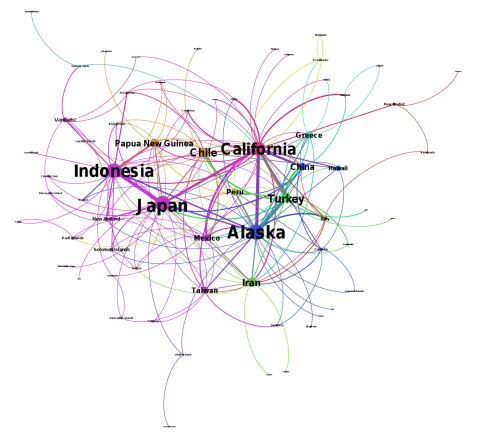The network of earthquakes
13/03/2011
The recent tragedies in Japan, New Zealand and Haiti had me thinking: how are the occurrences of earthquakes connected? The effects of the Pacific Ring of Fire are known: when something occurs in Japan, something can be expected in the US. Using the data of the biggest quakes in the world from U.S. Geological Survey, I used network analysis to answer the question: how do the earthquakes link?
 A link between two earthquake sites happens when a quake has happened directly after or one after the initial quake at least two in two occasions. The more common is the co-occurrence of quakes, the thicker is the connection between two nodes. The size of the node represents the amount of quakes happened. We see that Japan and Indonesia are strongly connected, as are Japan and California. The color of the connection represents the “community” of earthquakes: repeated co-occurrence.
A link between two earthquake sites happens when a quake has happened directly after or one after the initial quake at least two in two occasions. The more common is the co-occurrence of quakes, the thicker is the connection between two nodes. The size of the node represents the amount of quakes happened. We see that Japan and Indonesia are strongly connected, as are Japan and California. The color of the connection represents the “community” of earthquakes: repeated co-occurrence.
Could this method be used to predict future big earthquakes? Using the same data I highlighted the strings of earthquakes that have happened at least four times in a row. I accounted the last three big quakes: Chile, New Zealand and Japan. The stronger the color red, the bigger is historical change for big quake to happen.
 We see that Indonesia is likely to be hit next as well is California and Papua New Guinea. I have to note that my expertise is not in geology but in social network analysis. But never the less, if we accept that the movements in the crust of the Earth are not independent, network analysis can provide some insight into these life changing events.
We see that Indonesia is likely to be hit next as well is California and Papua New Guinea. I have to note that my expertise is not in geology but in social network analysis. But never the less, if we accept that the movements in the crust of the Earth are not independent, network analysis can provide some insight into these life changing events.
Visualization is made with Gephi.
Filed in data visualization, Gephi, network analysis, social network analysis, Uncategorized, verkostoanalyysi, visualisointi
13/03/2011 at 14:57
Impressive stuff! I suggest some infographics modding: implementing it to traditional world map or G Maps (easier to perceive), maybe adding subwaves (if any data available) and / or presented in timelime could be nice also how earthquakes have escalated during history.
Anyway, inspirative approach. Why not to contact and bother some geologist and make it to deeper interpretation? 🙂
15/03/2011 at 19:54
Thanks! Good suggestions. One option good be to try out dynamic network analysis and use the dataset as a temporal network.
I’ve contacted a couple of seismologists without answer. They may have some other things in their mind…
17/03/2011 at 13:50
Interesting. Indeed.